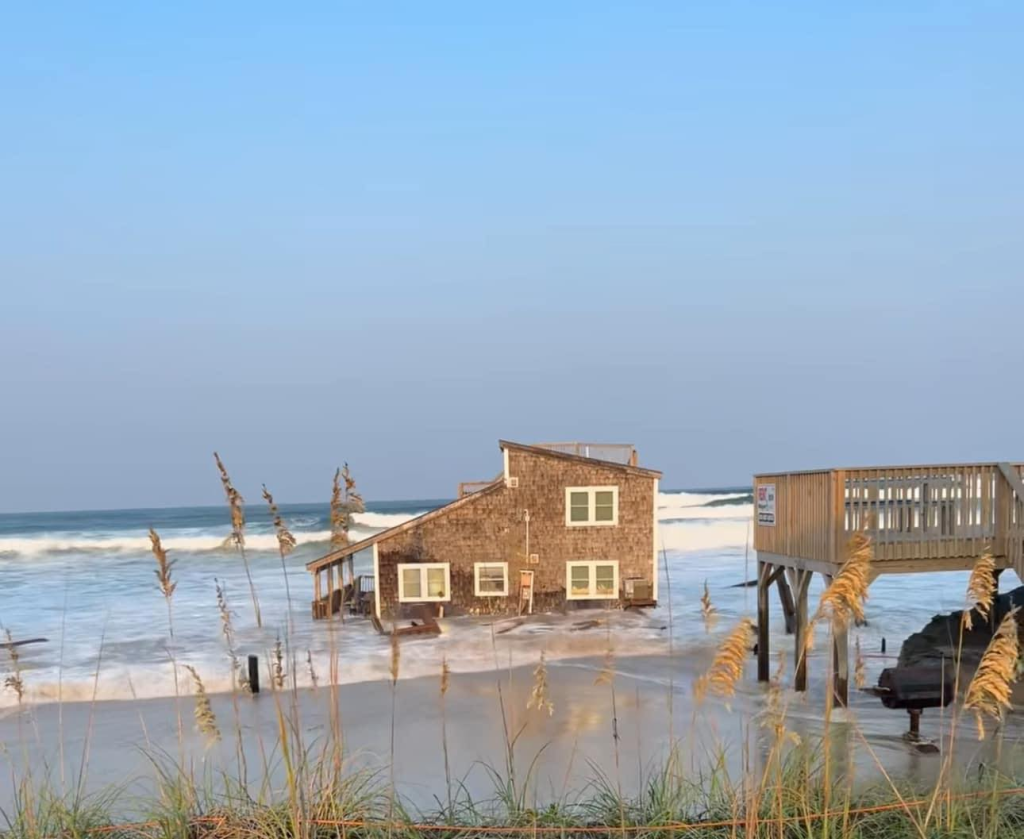A Predictable and Recurring Nightmare
In the picturesque community of Rodanthe, North Carolina, another beach house has succumbed to the relentless forces of nature, collapsing into the Atlantic Ocean on Friday, August 16. This latest incident marks the seventh home lost to the ocean in Rodanthe in the past four years, underscoring the growing threat of coastal erosion and the devastating impact of climate change on vulnerable coastal communities.
The house, located at 23214 Corbina Drive, was unoccupied at the time of its collapse, and thankfully, no injuries were reported. However, the dramatic event, captured on video and shared widely on social media, serves as a stark reminder of the precariousness of building homes along the rapidly eroding shorelines of the Outer Banks.
Force of Nature: Hurricane Ernesto
While the exact cause of the collapse is still under investigation, weather experts believe that Hurricane Ernesto, which was churning hundreds of miles away in the Atlantic, played a significant role. The storm generated powerful waves and unusually high tides that battered the North Carolina coastline, further weakening the already compromised structure.
Local officials noted that the house had been at risk of collapsing even before the storm, highlighting the long-term effects of rising sea levels and increasing storm intensity driven by climate change. As sea levels continue to rise, the shoreline in Rodanthe and other parts of the Outer Banks is retreating, putting more homes and infrastructure at risk of similar fates.
Coastal Erosion: A Growing Threat
Rodanthe, a small community with a population of about 200 people, has become an epicenter for discussions on climate change and coastal erosion. The repeated loss of homes in this area is not just a local issue; it is a symptom of a much larger, global problem. As sea levels rise and storms become more powerful, coastal communities around the world are facing an existential threat.

The collapse of beach houses in the Outer Banks is a vivid illustration of the dangers posed by these environmental changes. The erosion of natural barriers, such as dunes and vegetation, has left these homes more exposed to the elements. The result is a cycle of destruction that is becoming increasingly difficult to stop.
Weather Forecast in New York: Affected by the Same Storm
The effects of Hurricane Ernesto were not limited to the Outer Banks. In New York, the storm’s impact was felt in the form of dangerous rip currents that prompted the closure of several beaches in Queens and Brooklyn. Beaches such as Coney Island, Brighton Beach, and Rockaway Beach were closed to swimmers over the weekend due to life-threatening conditions caused by the storm.


New York City Parks officials issued warnings to residents and visitors to stay out of the water, emphasizing the dangers of rip currents, which can be deceptively powerful and unpredictable. Red flags were raised at affected beaches, and lifeguards were stationed to enforce the swimming ban.
The dangerous conditions were expected to persist throughout the weekend, with waves reaching heights of 4 to 8 feet. While the beaches were scheduled to reopen on Monday, the incident served as a reminder of how weather patterns in one part of the world can have far-reaching effects, even in places like Brooklyn and Queens.
Future of Coastal Communities Amidst Ongoing Climate Change
The collapse of yet another beach house in Rodanthe and the subsequent beach closures in New York highlight the urgent need for a reassessment of how and where we build our homes. Coastal erosion and rising sea levels are not problems that will go away on their own. They require coordinated efforts from governments, communities, and individuals to mitigate their impacts.
In the short term, there are measures that can be taken to protect homes and infrastructure, such as reinforcing dunes, installing seawalls, and relocating at-risk structures. However, in the long term, more drastic actions may be necessary, including the possibility of retreating from certain coastal areas altogether.

The story of Rodanthe is a cautionary tale, not just for North Carolina, but for all coastal communities facing the threat of climate change. It is a reminder that nature will always have the final say, and we must adapt if we are to survive in the face of these inevitable changes.
As the residents of Rodanthe continue to grapple with the loss of yet another home, the broader implications of this event resonate far beyond the Outer Banks. The collapse is a powerful symbol of the ongoing struggle between human development and the forces of nature, a struggle that is becoming increasingly one-sided as the effects of climate change become more pronounced. For now, the people of Rodanthe and other coastal communities can only brace for the next storm, hoping that their homes will withstand the rising tides and the ever-encroaching ocean.


